- Author says “carbon farming” can feed people while cooling the planet
- Farming methods like agroforestry exhibit the highest levels of biodiversity of any anthropogenic ecosystem
- Even industrial crops like oil palm and rubber can be grown in ways that have multiple positive benefits
Conversations that involve lowering the amount of carbon in the atmosphere by agricultural means rarely include the sort of techniques championed by award-winning author, Yale University lecturer, and Project Drawdown senior fellow Eric Toensmeier, but his new book, The Carbon Farming Solution, suggests that their popularity could be on the rise. By one estimate, a billion farmers worldwide are already practicing agroforestry, one method of “carbon farming.” Beside carbon sequestration, such techniques can also boost food production, biodiversity, water quality, and more. Toensmeier recently answered Mongabay’s questions about it during a wide-ranging conversation.
AN INTERVIEW WITH ERIC TOENSMEIER
Mongabay.com: As a climate solution, what does “carbon farming” offer?
Toensmeier: In order to avoid catastrophic climate change we need to return to 350 ppm of atmospheric carbon dioxide or below. Even if we stopped all emissions today, that would leave us stranded at over 400 ppm, well beyond the tipping point and on our way to a point of no return. So we need to remove the excess carbon dioxide in our atmosphere and store or “sequester” it somewhere safe. Reforestation is one great way to do that, but the need for farmland to feed humanity means that we can’t reforest enough to do the job. In fact, the total amount of storage capacity available in soil and biomass is much less than the amount of fossil fuel remaining underground. So only with an aggressive plan to reduce emissions and aggressive implementation of reforestation and carbon farming can we mitigate climate change to a safe level.
None of the carbon farming practices profiled in the book were developed for the purpose of climate mitigation. Their sequestration benefits are only gradually becoming understood. Instead they were created to provide productivity benefits on the farm and/or ecosystem services. Investing in carbon farming for climate mitigation brings co-benefits like biodiversity, reduced erosion, improved water quality, wildlife corridors, food security, avoided deforestation, and numerous other benefits to people and the environment.
Mongabay.com: How does it work?
Toensmeier: I always encourage people to remember photosynthesis in high school. This remarkable process captures atmospheric carbon  dioxide and breaks off the carbon, releasing oxygen for us to breathe. Some of this carbon stays in the tissues of a long-lived perennial plants for decades or centuries. In fact, if you were to dry out the average tree, about half the weight of its biomass would be carbon. Some of the carbon ends up in the soil by a slower process as well, through the decomposition of leaves and root hairs over time. This forms organic matter in the soil, also known as humus. Organic matter is about 57% carbon on a dry weight basis. Thus carbon farming systems remove atmospheric carbon and store it in this form of organic matter and perennial biomass. In the soil it can last for centuries if there is no return to tillage or poor management. In the form of trees it will last for decades or centuries. Both of these are temporary storages and vulnerable to disturbance, but they represent an important tool for climate change mitigation. From the farmer’s perspective, these practices can increase yields, rebuild degraded soils, and increase water-holding capacity.
dioxide and breaks off the carbon, releasing oxygen for us to breathe. Some of this carbon stays in the tissues of a long-lived perennial plants for decades or centuries. In fact, if you were to dry out the average tree, about half the weight of its biomass would be carbon. Some of the carbon ends up in the soil by a slower process as well, through the decomposition of leaves and root hairs over time. This forms organic matter in the soil, also known as humus. Organic matter is about 57% carbon on a dry weight basis. Thus carbon farming systems remove atmospheric carbon and store it in this form of organic matter and perennial biomass. In the soil it can last for centuries if there is no return to tillage or poor management. In the form of trees it will last for decades or centuries. Both of these are temporary storages and vulnerable to disturbance, but they represent an important tool for climate change mitigation. From the farmer’s perspective, these practices can increase yields, rebuild degraded soils, and increase water-holding capacity.
Mongabay.com: Can you describe the range of carbon farming systems covered in your book?
Toensmeier: In the book I break them up into several categories. The first involves growing annual crops like rice, wheat, and corn that we know and love in better ways. These include using cover crops, crop rotations, reducing tillage, applying compost or manure to fields, and more. This kind of practice tends to give a low or very low level of sequestration, but represents a major improvement over the carbon–emitting standard practices like annual tillage.

The second is agroforestry, the practice of integrating trees into agriculture. Many subsets of agroforestry work with annual crops, though others work with livestock or perennial crops. Some of these systems integrate timber trees or crop trees with annual crops. This has to be done carefully, with proper spacing to minimize competition. In fact when properly done, many of these systems out-produce monocultures, allowing us to grow more food on the land we have and resist the pressure of deforestation. Other systems integrate trees in a protective role, like windbreaks, or provide conservation benefits like riparian buffers along streams or erosion control strips planted on contour. Another group of agroforestry practices integrates nitrogen fixing trees and shrubs to provide fertility without the use of chemical fertilizer. Sequestration rates of these practices tend to be in the low to medium range in terms of tons per hectare per year – typically five times higher or more than the per hectare rates of improved annual cropping practices without trees.
The third category is better grazing practices. Overgrazing is well known as an environmental problem, but it is less well known that with proper stocking rates, periods of rest, and other practices, grazing can be beneficial to soils, carbon, and the surrounding ecosystems. The global average sequestration rates for these practices are very low, to low, but there is some evidence emerging that intensively managed systems with rotations may be able to sequester at a higher rate.
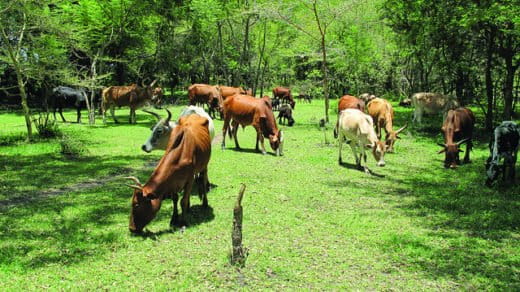
Far more powerful are agroforestry systems that integrate trees into pastures. Though most of the world’s grazing land is too dry, wherever trees can be grown these systems provide 5 to 10 times higher sequestration rates than managed grazing alone, a medium to high rate. Of particular interest are the recently developed intensive silvopasture systems, in which trees with high fodder value for livestock are planted at extremely high densities, like one per square meter, in improved pastures. Livestock are rotated through these fields and browse the foliage of the trees as well as the grass, and then are removed to allow for regrowth. These systems have very impressive carbon sequestration rates and produce a remarkable 2 to 10 times more meat or milk per hectare. Silvopasture systems provide net sequestration even though ruminant livestock like cattle produce emissions of their own, notably nitrous oxide and methane. The challenge is to ensure that sequestration rates offset and exceed these emissions. Several studies have found that methane and nitrous oxide emissions offset about 25% of the sequestration in managed grazing systems, while the far more powerful sequestration rates of silvopasture dwarfs the emissions from ruminants. In the case of silvopasture systems where the foliage of trees is fed to cattle, the tannins in the leaves actually reduce methane emissions, going even further to ensure climate-friendly livestock production.
Our fifth category is perennial systems, including perennial crops. This includes bamboo, perennial grains (which we will see more and more of in coming decades), tree crops, giant grasses, woody plants grown for biomass energy, and more. These tend to have a medium rate of sequestration.
Sixth we have polycultures of perennial plants, notably multi-strata agroforestry systems. These have the very highest levels of carbon sequestration of any food producing system. Notable examples include the shade production of coffee and cacao. Another example is the tropical home garden, a highly biodiverse production system found in backyards all around the humid tropics.

Finally we have a miscellaneous category that includes amendments like biochar, infrastructure like terraces and rainwater harvesting, and productive ecosystem management strategies.
Mongabay.com: How many farmers are already practicing some kind of agroforestry?
Toensmeier: It’s difficult to say exactly what the number is, though it is very high. Globally, of the roughly 1.2 billion ha of annual crops, about 700 million ha are intercropped with trees. Of 3.5 billion ha of grazing land, 450 million are in silvopasture. There are an additional 100 million ha of multi-strata agroforestry systems. Most of these are found in the tropics. It’s clear that this represents a very large number of farmers indeed. We can also look at other non-agroforestry carbon farming practices, like the System of Rice Intensification, a regenerative organic practice being implemented by an estimated 10 million farmers globally, mostly in southeast Asia.
Mongabay.com: Agroforestry systems clearly deliver benefits to humans like food, fiber, and medicine, but are they a threat to biodiversity?
Toensmeier: Clearing forest or otherwise converting intact ecosystems to agroforestry practices or other carbon farming practices is always a net loss for carbon and presumably for biodiversity as well. The real promise lies in converting the farmland we have, and the farmland that we have degraded and abandoned. In that case agroforestry conversion is almost always a net benefit to biodiversity. For example, scientists call the tropical home garden “the epitome of sustainability,” as among other benefits it has the highest levels of biodiversity of any anthropogenic ecosystem.
Mongabay.com: Yes, Roger Leakey noted in his book Living with the Trees of Life that home gardens in Indonesia contain 60-70% of the animal species, from birds to insects and monkeys, found in natural forests.

Toensmeier: I’ve seen some research about shade grown coffee systems in Mexico showing biodiversity levels not quite as good as intact forests but greatly superior to other land uses like pasture and annual crops. For example, there were almost as many frogs found in shade coffee as cloud forest, but only one or two species found in pastures. Many studies have found that converting annual cropland to perennial agriculture provides a major increase in habitat. Incorporation of perennial elements like hedgerows in annual cropland has a similar effect, particularly as wildlife corridors. Perennial crops, agroforestry systems, and other carbon farming practices also impact the wider environments by improving water quality and reducing erosion.
Another agroforestry system I should mention is the use of hedgerows of native plant species to provide habitat for beneficial insects that control pests. These hedgerows are also important for native pollinators. This kind of “farmscaping” is being promoted by the Xerces Society as a win–win for reduced pesticide use and increase habitat. Carbon sequestration is another, often unstated benefit.
Mongabay.com: How common is it for globally popular crops like cacao or coffee to be integrated into multi-strata, tree-cropping systems?
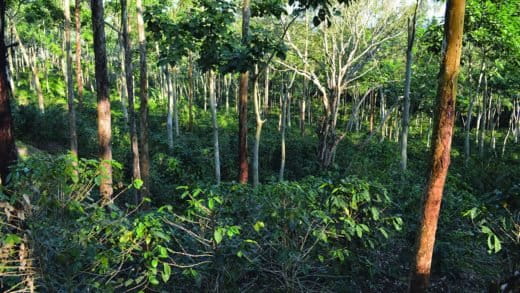
Toensmeier: Multi-strata systems occupy an estimated 100 million ha worldwide. If this were a single crop, it would be the fifth most widely produced after wheat, maize, rice, and soybeans. Not all coffee is grown in shade systems. Much is grown in full sun, typically a very chemically–intensive practice. About one third is grown in very simplified systems with a single species or few species of shade trees. But about one quarter of coffee is grown in highly complex and biodiverse agroforests.
Mongabay.com: Tropical “home gardens” have been cultivated for millennia around Asia, Africa, and Latin America, but is that system applicable in more temperate regions? How about savannahs and prairies?
Toensmeier: The tropical home garden goes back 13,000 years in Java, and is an ancient practice in tropical humid regions around the world. The system has extremely high biodiversity and excellent ecological and social co-benefits. I’m part of a movement that has been working to adapt these systems to other climates, particularly temperate ones, for the last 25 years. We are now moving from the garden scale to early–adopting small farms, and research is beginning for example at the University of Illinois, to look at commercial scale models for cold climates. Ideally each region can develop agricultural systems modeled on their natural vegetation types. This has been the vision of the Land Institute in Kansas for decades, which seeks to develop a mimic of the prairie to produce grains, legumes, and oilseeds from perennial plants, many domesticated from native species. The Savanna Institute in the upper Midwest region of the US is working to develop a savanna mimic, integrating pasture with woody crops.
Mongabay.com: Can you say more about growing grains?

Toensmeier: We can produce grains with carbon farming systems in any climate where grain grows today. There are several options for doing this. First we could grow annual grains in improved annual systems, adding elements like crop rotation, cover crops, reduced tillage, compost application, other organic practices and so on. Second, we can integrate perennials with those annual grains, for example by incorporating timber or crop trees on a wide spacing to allow sunlight for the grains, or using nitrogen fixing trees or strips of perennial grass on contour for fertility and erosion control. There’s also a new system called pasture cropping that grows winter–active (cool season) annual grains in summer–active (warm season) perennial grass pastures. Finally, perennial grains are under development and will eventually provide a true perennial alternative.
Mongabay.com: Some of the crops you discuss have industrial uses, like glues, fiber, starches, and fuel. Two that are currently driving conversion of native forests to monoculture are oil palm and rubber. Are there better ways to grow these?
Toensmeier: There’s nothing inherently wrong with industrial crops like African oil palm or cotton. We can’t blame them for the land grabs, slavery, colonization, and genocide that they have been associated with. It is human political, social, and economic systems that cause problems associated with these plants. Both rubber and African oil palm are suited to production in diverse polyculture systems, and both are grown commercially in such systems in some parts of the world. For example, in Indonesia a system called “jungle rubber” intercrops rubber trees with timber, fruits, medicinal plants, and building materials like rattan. The heavy shade cast by dense monoculture plantings of rubber is an impediment to intercropping, though many other crops are commonly grown with young rubber trees while they are establishing. In contrast the African oil palm is very well adapted to integrated polyculture systems. One study in Brazil found that when intercropped with nitrogen-fixing trees and groundcovers, fruit trees, black pepper vines, and cacao, oil palm yields went from five tons per hectare to upwards of eight, to which we must add the yield of the other crops. This is a great example of agroecological intensification, in which we grow more food on the land we have in a sustainable way, reducing deforestation pressure.
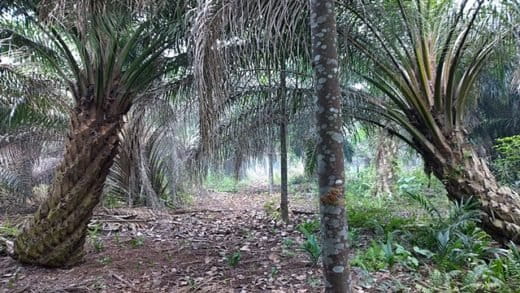
Mongabay.com: Where are carbon farming systems being researched and demonstrated?
Toensmeier: One of the most important research centers is the World Agroforestry Centre in Nairobi, Kenya. They are a world leader in researching and demonstrating agroforestry practices, primarily for tropical regions. China is a leader in development and large-scale practice of agroforestry for cold climates. A recent study also found that 14% of Europe’s farmland is in one form of agroforestry or another.
Many universities and NGOs are hard at work developing perennial crops and agroforestry systems. The University of Missouri for example is a leader in the United States. The Yunnan Academy of Agricultural Sciences in China has done fantastic work developing perennial rice. There’s a network of passionate individuals and very small organizations who have been at work to develop these systems for decades, like the Badgersett Research Corporation in Minnesota. A strong coalition called AgForward is leading agroforestry research in Europe today. Government agencies are also involved, for example the US Department of Agriculture has an agroforestry program.
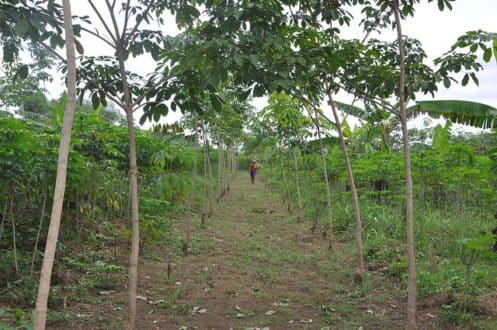
Mongabay.com: Your book came out just months after the Paris climate agreement. Was carbon farming on the agenda there?
Toensmeier: Yes, I think that Paris was the moment when agricultural mitigation came into its own as a solution. I saw it discussed at every level, from street protesters to government ministers. Each country that is participating submits an INDC (Intended Nationally Determined Contribution), which is a plan for climate change mitigation and adaptation, and agriculture and land-use are a big piece of those for many countries. Of course there is much room for improvement, as much of the discussion revolves around conservation agriculture and managed grazing, which have among the lowest per hectare sequestration rates of any carbon farming practice. I’d like to see much more emphasis placed on agroforestry and perennial crops, as they have a much greater potential mitigation impact.
Mongabay.com: Beside describing cropping systems and hundreds of species of useful plants and trees, your book discusses ways to support farmers in making a transition to carbon farming. What will it take for more people to become carbon farmers?

Toensmeier: One key piece is financing. For farmers to make the transition to agroforestry or other carbon farming practices, there’s typically a period of 2 to 5 years before they break even again. We need to help farmers make that transition, be it through loans, grants, government payment for environmental service programs, access to preferred markets, or other techniques. I would particularly like to see a mechanism for investors who are removing their funds from fossil fuels to be able to invest in agroforestry and other carbon farming systems.
Governments need to prioritize agricultural mitigation. One leader has been India, which has pledged to go from 25% forest cover to 33% primarily from implementing agroforestry on existing farms. Brazil has prioritized agroforestry as well, offering special loan programs and even requiring that public schools purchase a third of their food from local agroecological family farmers.
I’d also like to see a certification system analogous to “organic” or “bird–friendly,” which would provide a premium price to farmers. The Sustainable Agriculture Network, a program of Rainforest Alliance, already certifies over 200,000 farmers in Latin America and Africa for reducing emissions on their farms. This would be a great program to build upon.
There is a great need to remove subsidies for conventional agriculture and instead build incentives for farmers to transition to agroforestry and other carbon farming practices.
Mongabay.com: Can you describe a community making the shift to carbon farming?
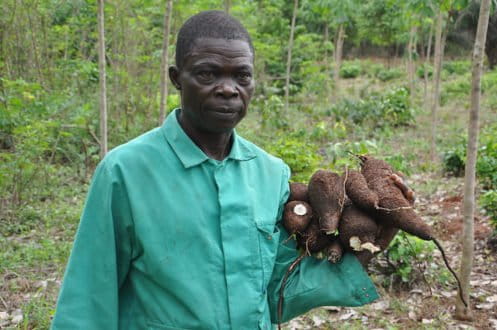
Toensmeier: One success I learned of recently is in southern Mexico. The national government, working with The Nature Conservancy, has assisted ranch owners to transition from pasture to silvopasture, with climate change mitigation as the motivation. Economists working for TNC learned that silvopasture is also much more profitable for the farmers, and allows the government to stop subsidizing grazing operations once it is established. That’s one key to success for this program, saving money for the government while helping farmers make more money.
Mongabay.com: It sounds like big institutions are picking up on the potential of carbon farming.
Toensmeier: Well, it is certainly much more prominent than it was even just a few years ago. I’m currently teaching a course on it at Yale, and I’ve been in conversation with several large foundations lately which are interested in funding this area. The Intergovernmental Panel on Climate Change includes agricultural mitigation in their publications. One key area that is missing is climate finance. Of the well over $300 billion funneled annually through the UN climate finance system, less than 2% goes to agriculture, and almost all of that is for emissions reductions from better management of manure from confined livestock operations and reducing the overuse of chemical fertilizers. Agroforestry receives roughly 0.02% of international climate finance money. It’s not enough to reduce emissions – we have to prioritize sequestration.
The Carbon Farming Solution was published in 2016 by Chelsea Green Publishing. Special thanks to World Agroforestry Centre for the use of images.
Correction: The Sustainable Agriculture Network is not a program of Rainforest Alliance, but rather a coalition of nonprofit conservation organizations “promoting the environmental and social sustainability of agricultural activities through the development of standards for best practices, certification and training for rural farmers around the world.”
